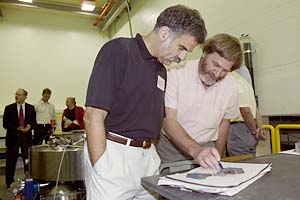Plasma studies unwinds a powerful COBRA for high-density simulations
By Bill Steele

The future of fusion power may lie not in a 20 million-ampere bang, but a 1-million-ampere pop.
"It's not as intense. You can take data more readily," explains Bruce Kusse, Director of the Laboratory of Plasma Studies at Cornell, describing COBRA 1-MA, a new machine capable of generating brief but intense bursts of X-rays by releasing a million amperes into a few wires in such a short time that the wires implode and are literally annihilated. The temperature created is so high that atoms are broken apart into ions and electrons, a state of matter known as a plasma.
Impressive as that sounds, COBRA (Cornell Beam Research Accelerator), housed in the Center for Pulsed-Power-Driven High-Energy-Density Plasma Studies in Grumman Hall, is dwarfed by the "Z-machine" at Sandia National Laboratories in Albuquerque, N.M., which fires off 20 million ampere pulses. Sandia's main focus is on the development of inertial confinement fusion. Intense beams of X-rays irradiate tiny pellets containing deuterium (heavy hydrogen) from all directions, compressing them and heating them to temperatures comparable to those in the sun, to cause the deuterium atoms to fuse into helium, releasing energy.
Cornell scientists, on the other hand, are studying the fundamental physics of the X-ray production and the behavior of high-density plasmas. The laboratory also plans to create simulations of high energy density astrophysical phenomena and study phase transitions in the dense matter created by the compression, such as the change from a liquid to solid state as the pressure is increased.
For inertial confinement experiments COBRA's huge current is fired through arrays of fine wires arranged in a cylinder. The current generates an intense magnetic field around each wire, pulling the wires together and compressing and heating them to form a plasma. The effect is called a "Z-pinch" because the current is initially flowing along the Z axis (i.e., down the center) of the cylinder formed by the wires.
COBRA can also be used to generate high-resolution X-ray images In an alternative configuration known as X-pinch, current is fired through two or more fine wires arranged to cross one another at a common point, generating an intense but very tiny plasma at the intersection. Because the X-rays come from such a tiny source they are capable of producing very high-resolution images of very tiny objects, such as parts of the anatomy of insects. The plasma lab is working with scientists in the College of Veterinary Medicine to determine whether this new imaging technology could have important applications for medicine or biology.
COBRA 1-MA, an upgrade of an earlier 500,000-ampere machine, was formally dedicated July 2 in a ceremony attended by officials of the Department of Energy. The original COBRA machine was financed by Sandia National Laboratories and funds for the upgrade were provided by the Department of Energy in its support of the Center for Pulsed Power Driven High Energy Density Plasma Studies.
Media Contact
Get Cornell news delivered right to your inbox.
Subscribe